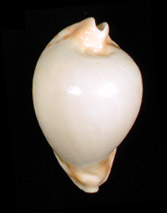| <
Previous family
introduction
|
|

|
Family
Cypraeidae
Cowry Shells |
|
The cowries are a relatively small family of about 200 species, but are the most collected of all seashells. Their combination of form, texture and colour have made them sought after from ancient times by connoisseurs and collectors. About two-thirds of the species of cowries occur in the tropics and sub-tropics on coral reefs. Most of these live intertidally, hiding under coral slabs or in crevices by day, emerging at night to feed. But some, particularly the large species such as the famous golden cowry, live subtidally and have only been commonly seen since the advent of scuba diving. The other third of the family occurs in temperate waters, both intertidally and down to at least 500 metres, with two groups restricted to Australia; the Zoila group in south-western West Australia and the Notocypraea group in southern Australia. The distinctive feature of the cowries is the animalís mantle that covers the outside of the shell. The mantle itself can be ornamented with papillae of various shape and colouration which serve to camouflage the animal in its habitat. When disturbed, the mantle is retracted into the shell revealing the shell surface kept naturally glossy by the mantle. The food source in the family is diverse; they feed on algae, sponges, dead organic matter and other molluscs. The cowries illustrate the position of NSW as being an intermediate faunal zone between the tropical Indo-West Pacific to the north and the cool Southern Australian zone to the south. Most of the species occurring in NSW are tropical Indo-West Pacific species, with the southern limit of this fauna being nearly at the NSW-Victorian border, although specimens are rare south of Sydney. The southern Australian Notocypraea group extends northwards into southern NSW, with specimens rarely being taken as far north as Sydney. The Eastern Australian Overlap Zone, which extends from Hervey Bay in the north to Green Cape in the south and almost exactly corresponds with the state borders of NSW, has its own distinct fauna, of which the cypraeid representative is the large and attractive deep-water species Cypraea hesitata. Family References
Identification Notes The dorsal surface, or dorsum, is the upper surface; the ventral surface or base is the lower surface bearing the aperture. Juvenile cowries appear quite different to adults; in juveniles, the shell is the typical gastropod shape with spire exposed and the outer lip thin. As the shell matures, the outer lip thickens and folds in, creating the narrow aperture of the adult shell, covering the spire in the process. In mature shells the top of the spire may not be evident, may protrude slightly, or be present within a pit at the posterior end. Most juvenile cowries are marked quite differently to the adult with a pattern of wide transverse bands, the adult colour pattern developing as the shell matures. Coverage There are 51 species of Cypraeidae recorded from NSW. The 12 that occur most commonly around Sydney are figured here and the remaining species are listed below. Some caution is needed in interpreting the list of cowries which occur in NSW. Cowries have been intensively collected and recorded in NSW over the last two hundred years, which has resulted in the existence of specimens in collections and of records out of proportion to their frequency of occurrence. Thus, for some of the species in the list below, the southern limit of the range is based on only one or two specimens collected in the last hundred years. Species widespread in the tropical Indo-West Pacific and uncommonly or rarely occurring in NSW:
One species is endemic to eastern Australia:
Species with a southern Australian distribution, rarely occurring in southern NSW:
|